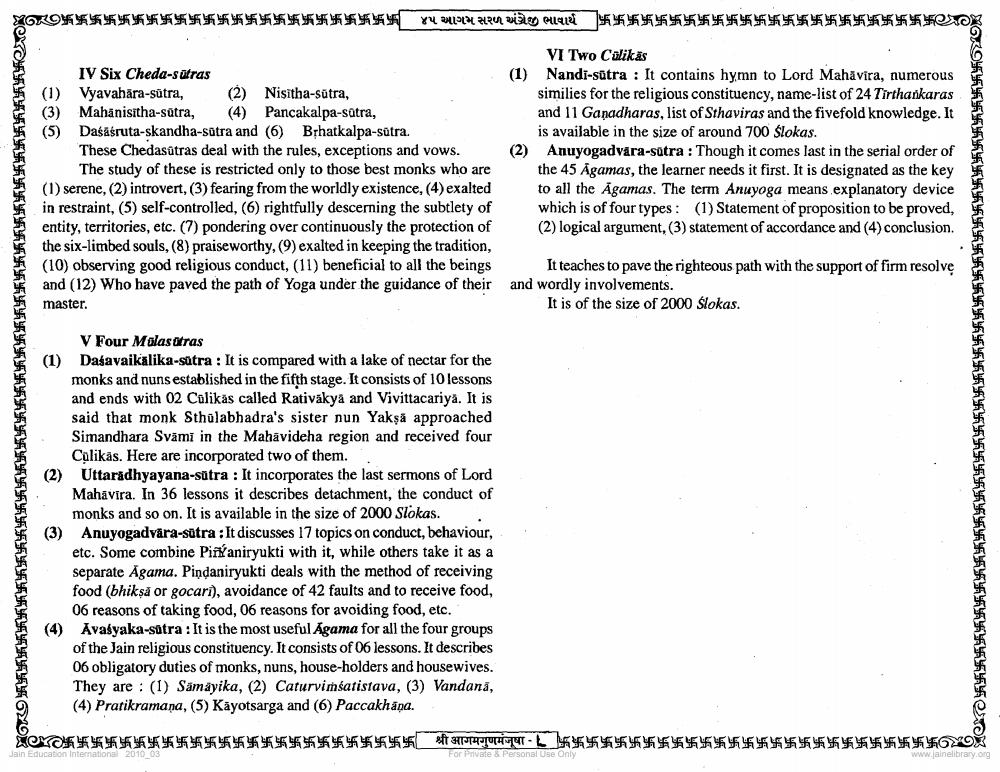Book Title: Agam 07 Ang 07 Upashak Dashang Sutra Shwetambar Agam Guna Manjusha Author(s): Gunsagarsuri Publisher: Jina Goyam Guna Sarvoday Trust Mumbai View full book textPage 7
________________ *********** IV Six Cheda-sūtras ********** (2) Nisitha-sūtra, (4) Pancakalpa-sutra, YU MUNU AM VIÀO QUN ********¶¶¶¶¶¶¶¶¶¶¶ (1) Vyavahara-sutra, (3) Mahānisitha-sutra, (5) Daśāśruta-skandha-sūtra and (6) Bṛhatkalpa-sūtra. These Chedasûtras deal with the rules, exceptions and vows. The study of these is restricted only to those best monks who are (1) serene, (2) introvert, (3) fearing from the worldly existence, (4) exalted in restraint, (5) self-controlled, (6) rightfully descerning the subtlety of entity, territories, etc. (7) pondering over continuously the protection of the six-limbed souls, (8) praiseworthy, (9) exalted in keeping the tradition, (10) observing good religious conduct, (11) beneficial to all the beings and (12) Who have paved the path of Yoga under the guidance of their master. V Four Malasitras (1) Daśavaikalika-sutra: It is compared with a lake of nectar for the monks and nuns established in the fifth stage. It consists of 10 lessons and ends with 02 Cūlikäs called Rativakya and Vivittacariya. It is said that monk Sthulabhadra's sister nun Yakşă approached Simandhara Svāmi in the Mahāvideha region and received four Culikās. Here are incorporated two of them. (2) Uttaradhyayana-sutra: It incorporates the last sermons of Lord Mahavira. In 36 lessons it describes detachment, the conduct of monks and so on. It is available in the size of 2000 Slokas. (3) Anuyogadvara-sutra: It discusses 17 topics on conduct, behaviour, etc. Some combine Pifaniryukti with it, while others take it as a separate Agama. Pindaniryukti deals with the method of receiving food (bhiksă or gocari), avoidance of 42 faults and to receive food, 06 reasons of taking food, 06 reasons for avoiding food, etc. (4) Avasyaka-sutra: It is the most useful Agama for all the four groups Jain Education International 2010 03 of the Jain religious constituency. It consists of 06 lessons. It describes 06 obligatory duties of monks, nuns, house-holders and housewives. They are (1) Samayika, (2) Caturvimśatistava, (3) Vandana, (4) Pratikramana, (5) Kayotsarga and (6) Paccakhāṇa. VI Two Culikäs (1) Nandi-sütra: It contains hymn to Lord Mahavira, numerous similies for the religious constituency, name-list of 24 Tirthankaras and 11 Gaṇadharas, list of Sthaviras and the fivefold knowledge. It is available in the size of around 700 Ślokas. (2) Anuyogadvara-sutra: Though it comes last in the serial order of the 45 Agamas, the learner needs it first. It is designated as the key to all the Agamas. The term Anuyoga means explanatory device which is of four types: (1) Statement of proposition to be proved, (2) logical argument, (3) statement of accordance and (4) conclusion. It teaches to pave the righteous path with the support of firm resolve and wordly involvements. It is of the size of 2000 Ślokas. ¶¶¶¶¶¶¶¶¶¶¶¶¶¶¶¶¶¶__¶¶¶¶¶¶¶¶¶¶¶¶¶¶¶¶¶¶¶¶¶¶¶¶¶¶ For Private & Personal Use Only www.jainelibrary.orgPage Navigation
1 ... 5 6 7 8 9 10 11 12 13 14 15 16 17 18 19 20 21 22 23 24 25 26 27 28 29
